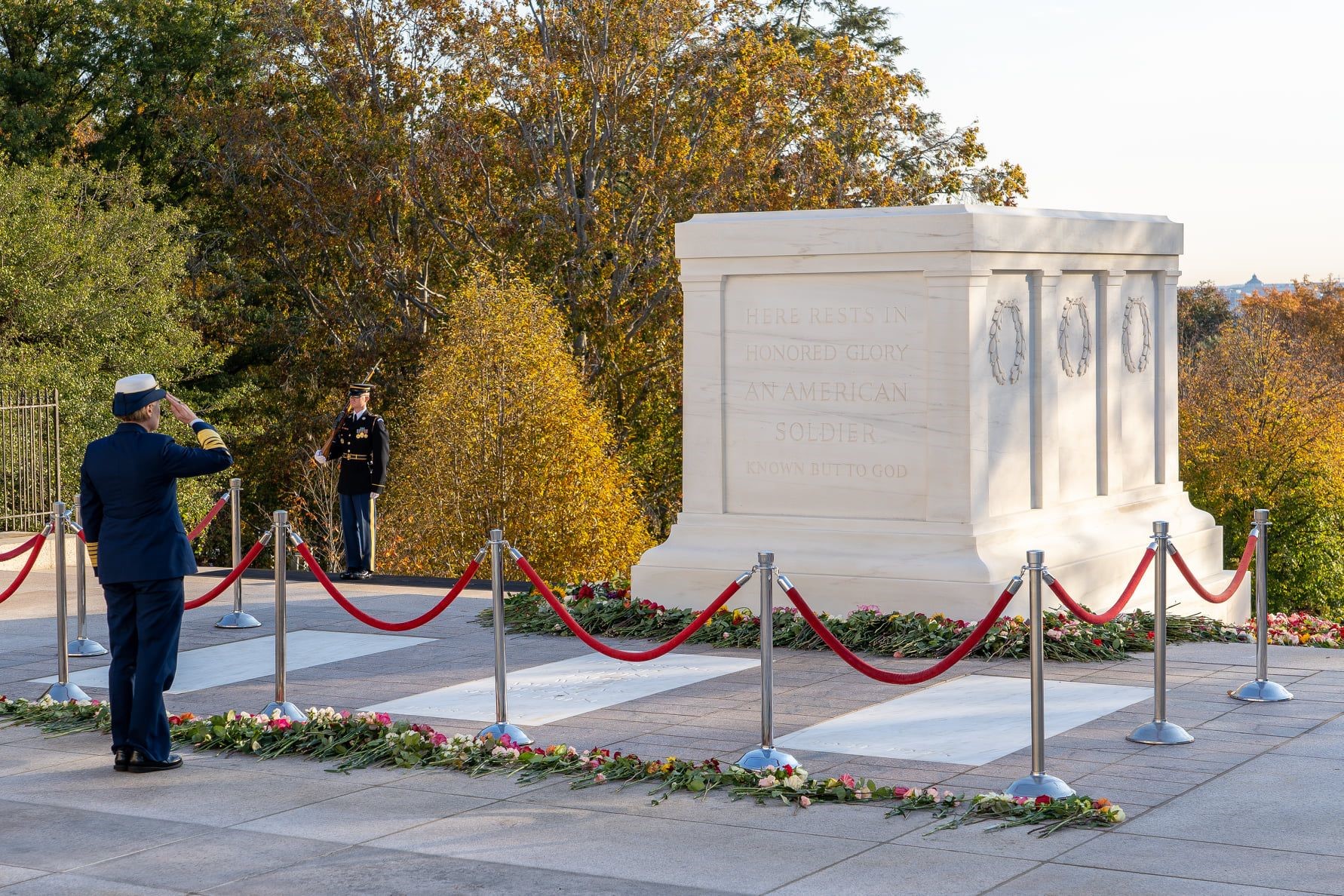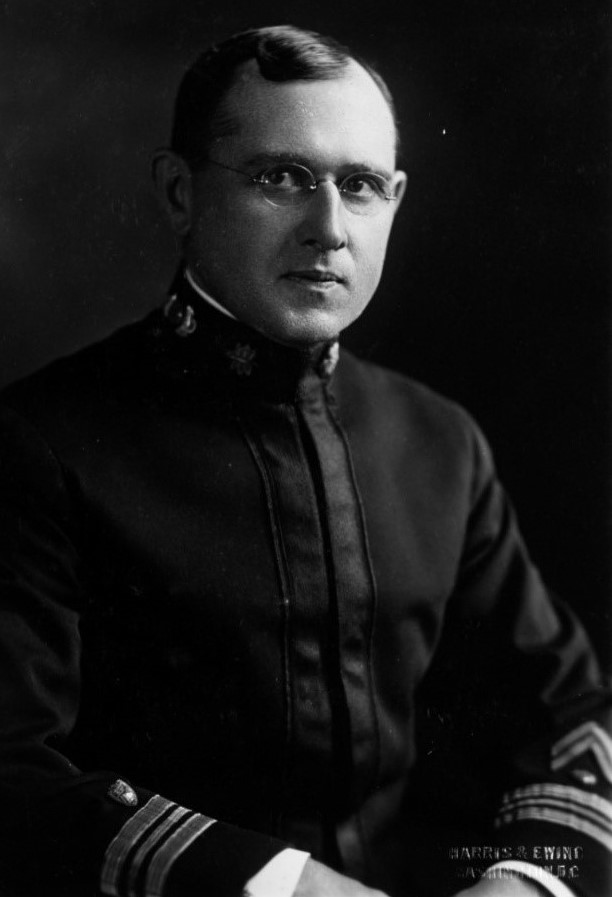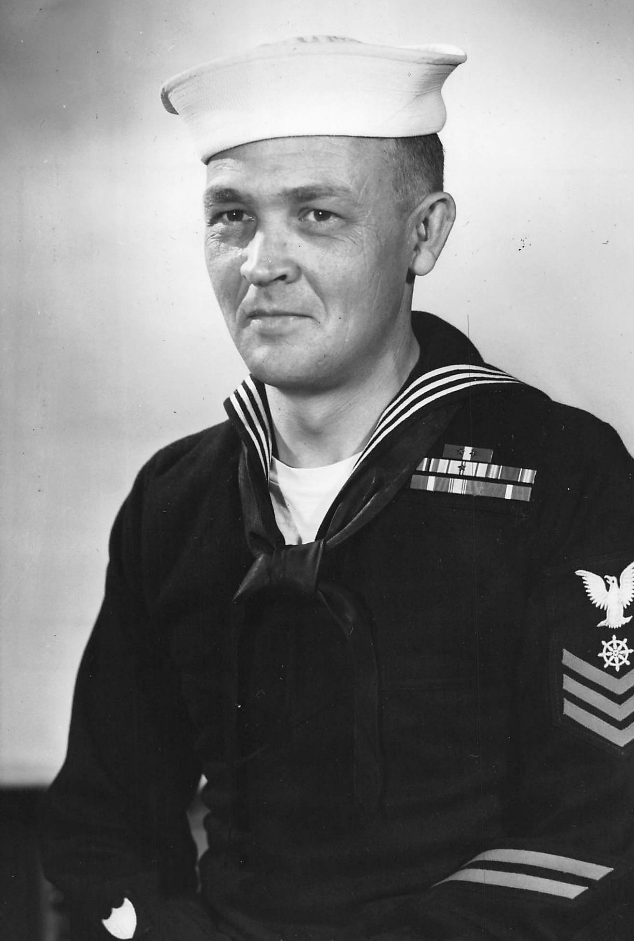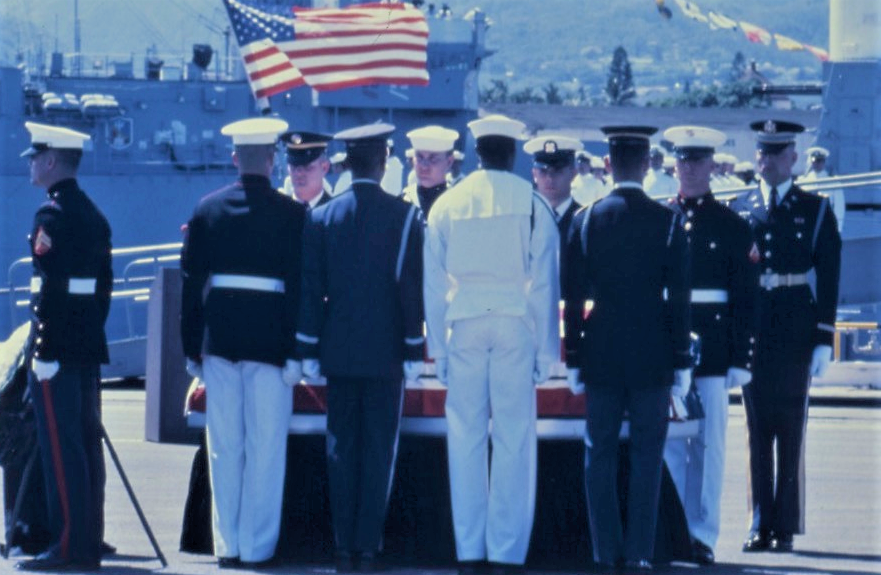
On May 27, 1958, the Coast Guard cutter Ingham quietly escorted the Navy destroyer USS Blandy up the Potomac River towards Washington, D.C. Blandy carried the remains of two unidentified American service members, one from World War II and one from the Korean War. Their final resting place would be at the Tomb of the Unknown Soldier at Arlington National Cemetery. Since its creation in 1921, the Tomb has become a symbol of valor and sacrifice during wartime. The Coast Guard has participated in all three of the ceremonies connected to interments at the Tomb—an acknowledgement of the numerous unrecoverable and unidentifiable Coast Guard service members lost over the years who are memorialized at the Tomb.
The Coast Guard’s Role in the 1921 Ceremony for the Unknown Soldier of World War I
The Coast Guard has been involved with the rituals of remembrance at the Tomb of the Unknown Soldier since the 1921 burial of the World War I Unknown, which inaugurated the Tomb. In 1921, the Coast Guard was still in its infancy, as the United States Revenue Cutter Service and the United States Lifesaving Service had merged just six years earlier, in 1915, to form the present-day United States Coast Guard. However, after its active role in World War I as part of the Navy, the Coast Guard had earned its place in the 1921 ceremonies surrounding the burial of the Unknown Soldier. In fact, the Coast Guard had its own missing an unidentifiable service members lost during the war, including unknown remains. For example, a seaman lost when the Coast Guard cutter Tampa sank on September 26, 1918, is buried in a churchyard in Wales in an unknown grave.
 On the day of the funeral for the World War I Unknown, Commandant of the Coast Guard William E. Reynolds (pictured at right), walked in the procession from the U.S. Capitol to Arlington, next to Chief Justice of the Supreme Court William E. Taft, who had earlier served as president of the United States. At least four Coast Guardsmen walked with President Warren G. Harding’s entourage: Lieutenant Philip F. Roach, Lieutenant (jg) Milton R. Daniels, Boatswain’s Mate Howard A. White of the Coast Guard cutter Acushnet, and Motor Machinist’s Mate First Class Patrick McCarthy, stationed on the Coast Guard cutter Calumet. All four men had served in the European theater during World War I. Other members of the Coast Guard also marched in the procession.
On the day of the funeral for the World War I Unknown, Commandant of the Coast Guard William E. Reynolds (pictured at right), walked in the procession from the U.S. Capitol to Arlington, next to Chief Justice of the Supreme Court William E. Taft, who had earlier served as president of the United States. At least four Coast Guardsmen walked with President Warren G. Harding’s entourage: Lieutenant Philip F. Roach, Lieutenant (jg) Milton R. Daniels, Boatswain’s Mate Howard A. White of the Coast Guard cutter Acushnet, and Motor Machinist’s Mate First Class Patrick McCarthy, stationed on the Coast Guard cutter Calumet. All four men had served in the European theater during World War I. Other members of the Coast Guard also marched in the procession.
 The biographies of two of the Coast Guardsmen who marched in the procession demonstrate the different ways the Coast Guard participated in World War I. Lieutenant Roach (pictured at left) was born on February 11, 1881 in Sedalia, Colorado. He graduated from the Revenue Cutter Service’s School of Instruction (now the Coast Guard Academy) in 1907 and served on the Coast Guard cutter Manning and Coast Guard-crewed vessel USS Lydonia during World War I. For this service, he received the Navy Cross. In November 1921, the 40-year-old Lt. Roach was stationed on the cutter Seneca. He retired in 1948 as a rear admiral, after 41 years of service, and died on March 8, 1976 at the age of 95. Rear Adm. Roach is buried in Section 53 of Arlington National Cemetery.
The biographies of two of the Coast Guardsmen who marched in the procession demonstrate the different ways the Coast Guard participated in World War I. Lieutenant Roach (pictured at left) was born on February 11, 1881 in Sedalia, Colorado. He graduated from the Revenue Cutter Service’s School of Instruction (now the Coast Guard Academy) in 1907 and served on the Coast Guard cutter Manning and Coast Guard-crewed vessel USS Lydonia during World War I. For this service, he received the Navy Cross. In November 1921, the 40-year-old Lt. Roach was stationed on the cutter Seneca. He retired in 1948 as a rear admiral, after 41 years of service, and died on March 8, 1976 at the age of 95. Rear Adm. Roach is buried in Section 53 of Arlington National Cemetery.
 Born on February 25, 1889 in Washington, D.C., Lt. Daniels (pictured at right) was the son of a telegraph operator. A 1911 graduate of the School of Instruction, Daniels served as the executive officer of the Coast Guard-crewed USS Cythera during World War I. By November 1921, the 39-year-old Daniels was stationed at headquarters in Washington, D.C. as a supervisor of construction and repairs. He later became the engineer officer and executive officer at the Coast Guard Yard in Curtis Bay, Maryland. Daniels retired as a captain on March 1, 1951 after 41 years of service. Captain Daniels passed away at the age of 87 on April 1, 1976, and is also buried at Arlington National Cemetery, in Section 11.
Born on February 25, 1889 in Washington, D.C., Lt. Daniels (pictured at right) was the son of a telegraph operator. A 1911 graduate of the School of Instruction, Daniels served as the executive officer of the Coast Guard-crewed USS Cythera during World War I. By November 1921, the 39-year-old Daniels was stationed at headquarters in Washington, D.C. as a supervisor of construction and repairs. He later became the engineer officer and executive officer at the Coast Guard Yard in Curtis Bay, Maryland. Daniels retired as a captain on March 1, 1951 after 41 years of service. Captain Daniels passed away at the age of 87 on April 1, 1976, and is also buried at Arlington National Cemetery, in Section 11.
The 1958 Ceremony for the Unknowns of World War II and the Korean War
The Coast Guard also played a prominent role in the burial ceremony for the World War II and Korean War Unknowns in May 1958. Most importantly, the Coast Guard cutter Ingham escorted the Navy destroyer Blandy as it transported the remains of the World War II and Korean War Unknowns. When these ships arrived at the Naval Gun Factory in Washington in May 1958, they were greeted by solemn fanfare and a large detail of active duty servicemen from all five branches of the armed forces. Accompanied by an honor guard, the caskets of these two unknowns were brought ashore from below deck to the fantail ceremonial area in preparation for the official burial ceremony the next day. Five Coast Guardsmen served as pallbearers—among them Quartermaster First Class Lennox A. Johnson of the Third District (Norfolk, Virginia), Boatswain’s Mate First Class Joseph F. Knoll of Coast Guard Cutter Westwind; and Aviation Machinist’s Mate Joseph F. Fachko of Coast Guard Air Station Salem, Massachusetts.
 Lennox Johnson (pictured at left), 32, from North Carolina, had served in the Navy during World War II and enlisted in the Coast Guard in February 1949. Being chosen as a Coast Guard pallbearer for the Tomb of the Unknown Soldier was quite an honor for him. Years later, he would visit the Tomb several times with his grandchildren, observe the changing of the guard, and tell the story of his role in the 1958 ceremony. He retired as a lieutenant commander in 1974 after serving in Korea and Vietnam, and he passed away at age 72 in 1998. Johnson is buried in Section 68 of Arlington National Cemetery. His legacy lives on in his granddaughter, Lt. Cdr. Michelle McNally, USCG. Johnson had grown vegetables during his retirement in Florida, and as he walked the rows of vegetables with his grandchildren, who spent summers with him, he would tell them stories of his youth and military service. These stories so impressed McNally that she enlisted in the Coast Guard in 2004. Today, she is the commanding officer of the Coast Guard Cryptological Unit in Washington, D.C.
Lennox Johnson (pictured at left), 32, from North Carolina, had served in the Navy during World War II and enlisted in the Coast Guard in February 1949. Being chosen as a Coast Guard pallbearer for the Tomb of the Unknown Soldier was quite an honor for him. Years later, he would visit the Tomb several times with his grandchildren, observe the changing of the guard, and tell the story of his role in the 1958 ceremony. He retired as a lieutenant commander in 1974 after serving in Korea and Vietnam, and he passed away at age 72 in 1998. Johnson is buried in Section 68 of Arlington National Cemetery. His legacy lives on in his granddaughter, Lt. Cdr. Michelle McNally, USCG. Johnson had grown vegetables during his retirement in Florida, and as he walked the rows of vegetables with his grandchildren, who spent summers with him, he would tell them stories of his youth and military service. These stories so impressed McNally that she enlisted in the Coast Guard in 2004. Today, she is the commanding officer of the Coast Guard Cryptological Unit in Washington, D.C.
 Born in Buffalo, New York to parents of Polish and Slovakian descent, James Fachko (pictured at right) enlisted in the Coast Guard in 1948, at age 18. He was stationed at Coast Guard Air Station Salem starting in December 1953 and was instrumental in the rescue of survivors of the Andrea Doria and Stockholm collision in July 1956. He retired as a master chief petty officer in 1971, and his stories of his service helped recruit his son and nephew. Fachko passed away in June 2022 at the age of 92. He and his late wife will be inurned at Arlington National Cemetery.
Born in Buffalo, New York to parents of Polish and Slovakian descent, James Fachko (pictured at right) enlisted in the Coast Guard in 1948, at age 18. He was stationed at Coast Guard Air Station Salem starting in December 1953 and was instrumental in the rescue of survivors of the Andrea Doria and Stockholm collision in July 1956. He retired as a master chief petty officer in 1971, and his stories of his service helped recruit his son and nephew. Fachko passed away in June 2022 at the age of 92. He and his late wife will be inurned at Arlington National Cemetery.
The 1984 Ceremony for the Vietnam War Unknown

Vietnam War Unknown Selection Ceremony, Pearl Harbor Naval Base, Hawaii, May 17, 1984.
After the Vietnam War, plans eventually coalesced to inter an unknown service member from that conflict at the Tomb. On May 17, 1984, the Vietnam Unknown Soldier was formally chosen at Pearl Harbor Naval Base in Hawaii. The casket was then placed on the Navy destroyer Brewton for the voyage to Alameda Naval Air Station in California. Coast Guard cutter Storis escorted the Brewton, arriving on May 24. Storis was an Arctic Patrol cutter based in Alaska, but was temporarily on refresher training with the U.S. Navy in Hawaii. Two Coast Guard patrol boats, Point Harris and Cape Corwin, steamed with Storis as it left Pearl Harbor. Some fifty miles out in the Pacific Ocean, Storis was relieved by another Coast Guard cutter, Midgett.
Upon arrival at San Francisco, the casket was then taken to Travis Air Force Base, some 40 miles north, for repose until the next morning, when it was flown to Washington, D.C. The Vietnam War Unknown lay in state at the U.S. Capitol Rotunda for three days as thousands of Americans paid their respects. On May 28, the day of the funeral, pallbearers carried the Unknown out of the Capitol to the caisson which would transport him to the cemetery. As the pallbearers descended the steps, the United States Coast Guard Band played four “Ruffles and Flourishes,” along with the Jewish prayers “Yigdahl Eloheen Chahi” (Great Is Our Living God) and “A-dohn Oh-lom” (Lord of the World). After the caisson arrived at the cemetery, President Ronald Reagan presided over the official burial, and just before the interment, the Chaplain of the Coast Guard, Capt. Eddy B. Moran, read the final blessing. However, in 1998, the body was exhumed and identified as Air Force Lieutenant Michael J. Blassie. He was reinterred at Jefferson Barracks National Cemetery in St. Louis, Missouri, and the Vietnam crypt at Arlington remains empty to this day.
The United States Coast Guard’s long history of valor and ultimate sacrifice—including missing and unknown fatalities—has been represented at the Tomb of the Unknown Soldier since its inception in 1921. By participating in the events surrounding each of the three burial ceremonies, the Coast Guard has demonstrated its important place in American military history and its own legacy of lost service members. The Tomb of the Unknown Soldier honors these missing and unidentified Coast Guard service members alongside every other branch of the military, ensuring they will never be forgotten.
Image Credits (top to bottom)
1. Official Facebook page for the Vice Commandant of the Coast Guard
2. U.S. Coast Guard Historian’s Office
3. Naval History and Heritage Command
4. Tide Rips, Coast Guard Academy
5. U.S. Coast Guard Honor Guard, Alexandria, Virginia
6. U.S. Coast Guard Honor Guard, Alexandria, Virginia
7. U.S. Coast Guard Historian’s Office
Selected Sources Consulted
• Files of the Coast Guard Honor Guard, Alexandria, Virginia.
• Hammond, William M. The Unknown Serviceman of the Vietnam Era. Washington, D.C: U.S. Army Center of Military History, 1985.
• Interview, Nora L. Chidlow with Lt. Cmdr. Michelle McNally, November 2021.
• Kroll, C. Douglas. A History of Navy Chaplains Serving with the U.S. Coast Guard. Washington, D.C.: U.S. Navy Chaplains Corps, 1993.
• Mossman, B.C. and M.W. Stark, The Last Salute: Civil and Military Funerals, 1921-1969. Washington, D.C.: Department of the Army, 1991.
• National Archives and Records Administration (College Park, MD), Record Group 26 (Records of the U.S. Coast Guard), Entry 82A, Box 1490.
• National Archives and Records Administration (College Park, MD), Record Group 407 (Records of the Adjutant General's Office), Entry 37, Box 564.
• United States Coast Guard Historian's Office, "Chronology of Coast Guard History.”
• United States Coast Guard Historian's Office, “The U.S. Coast Guard & Lighthouse Service in World War I."
• United States Coast Guard Historian’s Office (Washington, D.C.), Philip Roach Personnel File.
• United States Coast Guard Historian’s Office (Washington, D.C.), Milton Daniels Personnel File.